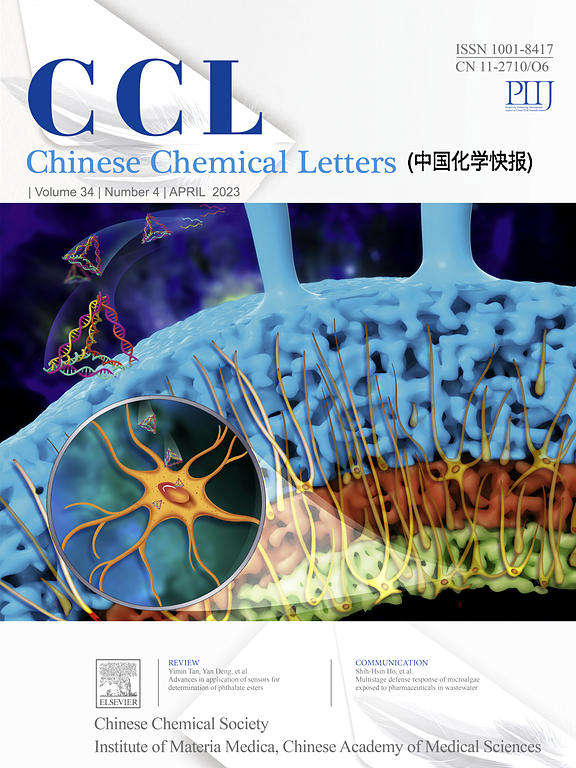A near-infrared fluorescent probe based on Au3+/Pd2+ complexes for glutathione sensing: Applications in acute liver injury, hepatocellular carcinoma, and ferroptosis exploration
IF 8.9
1区 化学
Q1 CHEMISTRY, MULTIDISCIPLINARY
引用次数: 0
Abstract
Liver diseases, particularly acute alcoholic liver injury (AALI), drug-induced liver injury (DILI), and hepatocellular carcinoma (HCC), have become global public health issues. Glutathione (GSH), as an important antioxidant, plays a crucial role in the liver, and its changes are closely associated with liver injury and the development of liver cancer. Therefore, accurately monitoring GSH variations is critical for understanding liver injury mechanisms, early diagnosis, and treatment evaluation. However, traditional detection methods suffer from insufficient sensitivity and selectivity. To address these challenges, we developed an innovative DR-Au3+/DR-Pd2+ complex probe that can rapidly and sensitively detect GSH through near-infrared (NIR) fluorescence changes. This probe, with the optimal excitation and emission wavelengths of the probe both located in the NIR region, exhibits excellent selectivity and liver-targeting ability, overcoming the imprecision localization problems of traditional methods. In the AALI and DILI models, the optimized DR-Au3+ probe enables real-time monitoring of GSH level fluctuations, providing a powerful tool for early diagnosis of liver injury and dynamic evaluation of therapeutic efficacy. In the DILI and HCC models, the DR-Au3+ probe enables visualization and quantitative monitoring of the ferroptosis process, offering new perspectives and approaches for targeted therapy research. The DR-Au3+ probe we developed pioneers innovative strategies for establishing accurate diagnostic protocols and individualized therapeutic regimens in hepatic injury and hepatocellular carcinoma management.

一种基于Au3+/Pd2+配合物的近红外荧光探针用于谷胱甘肽检测:在急性肝损伤、肝细胞癌和铁凋亡探测中的应用
肝脏疾病,特别是急性酒精性肝损伤(AALI)、药物性肝损伤(DILI)和肝细胞癌(HCC),已成为全球公共卫生问题。谷胱甘肽(GSH)作为一种重要的抗氧化剂,在肝脏中起着至关重要的作用,其变化与肝损伤和肝癌的发生密切相关。因此,准确监测谷胱甘肽的变化对于理解肝损伤机制、早期诊断和治疗评估至关重要。然而,传统的检测方法存在灵敏度和选择性不足的问题。为了解决这些挑战,我们开发了一种创新的DR-Au3+/DR-Pd2+复合探针,可以通过近红外(NIR)荧光变化快速灵敏地检测GSH。该探针的最佳激发波长和发射波长均位于近红外区,具有优异的选择性和肝脏靶向能力,克服了传统方法定位精度不高的问题。在AALI和DILI模型中,优化后的DR-Au3+探针可以实时监测GSH水平的波动,为肝损伤的早期诊断和治疗效果的动态评估提供了有力的工具。在DILI和HCC模型中,DR-Au3+探针可以可视化和定量监测铁下垂过程,为靶向治疗研究提供新的视角和方法。我们开发的DR-Au3+探针为建立肝损伤和肝细胞癌管理的准确诊断方案和个性化治疗方案开辟了创新策略。
本文章由计算机程序翻译,如有差异,请以英文原文为准。
求助全文
约1分钟内获得全文
求助全文
来源期刊

Chinese Chemical Letters
化学-化学综合
CiteScore
14.10
自引率
15.40%
发文量
8969
审稿时长
1.6 months
期刊介绍:
Chinese Chemical Letters (CCL) (ISSN 1001-8417) was founded in July 1990. The journal publishes preliminary accounts in the whole field of chemistry, including inorganic chemistry, organic chemistry, analytical chemistry, physical chemistry, polymer chemistry, applied chemistry, etc.Chinese Chemical Letters does not accept articles previously published or scheduled to be published. To verify originality, your article may be checked by the originality detection service CrossCheck.
 求助内容:
求助内容: 应助结果提醒方式:
应助结果提醒方式:


